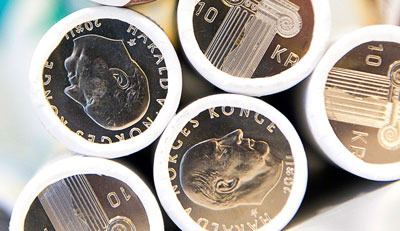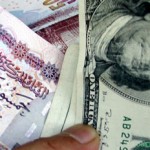Currency Traders Stuck in Norway as Volatility Whipsaws Market

Just because a currency is from a Group of 10 nation doesn’t mean it will be easy to sell when markets become volatile.
Norway’s krone saw the biggest jump in anticipated price swings of any of its major peers over the past month, exceeding emerging-market currencies such as Turkey’s lira and Brazil’s real. A string of disappointing economic data in recent weeks had investors rushing for the exits, sending the krone tumbling on June 5 to its lowest level in almost three months versus the euro.
The problem is that the krone is the least-liquid currency in the G-10, according to the Bank for International Settlements, meaning moves tend to be exaggerated. On Wednesday, for example, it rallied the most since mid-April and strengthened versus most of its peers after an inflation report beat economists’ estimates.
“Liquidity is really poor and that’s the reason why you see these huge moves,” said Richard Falkenhall, senior currency strategist in Stockholm at SEB AB, Scandinavia’s biggest foreign-exchange trader. “The market becomes one-sided every time anything unexpected happens in the Norwegian economy. It’s very hard to get out at a reasonable level. It’s the same problems you have in emerging-market currencies.”
Oil Effect
As the currency of western Europe’s biggest oil producer, the krone has been weighed down for much of the past year as crude shed almost half its value. It sank to 8.8692 per euro at the end of last week, the lowest level since March 19, after data showed worse-than-predicted declines in the nation’s manufacturing and industrial sectors.
The krone then climbed 0.7 percent to 8.7194 as of 10:02 a.m. London time on Wednesday after data showed underlying consumer-price inflation rose 0.5 percent in May from a month earlier. The forecast in a Bloomberg survey was for a 0.3 percent increase.
SEB’s Falkenhall said the lackluster economy would prompt the central bank to lower borrowing costs at its policy meeting this month after a cut in December left the key deposit rate at a record-low 1.25 percent. Given the scale of the krone’s recent losses, though, he predicted the currency would rebound to 8.2 to 8.25 per euro by year-end.
“After weeks of being one of the most dormant currencies in the G-10, a string of weak figures forced through a sharp rise in expectations for additional accommodation by Norges Bank,” Geoffrey Yu, senior foreign-exchange strategist at UBS Group AG in London, wrote in a June 8 report.
While trading in Norway’s currency surged to 123 percent of its yearly average last week as investors pulled out, according to Yu, it was still a fraction of volumes in the euro. Shorts, or bets the krone would weaken, increased to 30 percent of net trading last week, he wrote, amid a “sharp” liquidation.
‘Sharp’ Liquidation
Implied one-month euro-krone volatility climbed to 11.8 percent on Tuesday, the highest since March 19 and up from 8.9 percent on May 8. That’s the biggest increase among 25 major currencies tracked by Bloomberg in the past month, a period when global markets were whipsawed as investors re-assessed the outlook for the world’s largest economies.
When Norway’s policy makers refrained from an interest-rate reduction on March 19 that had been forecast by strategists, the krone surged 2.8 percent versus the euro, the most since the depths of the global financial crisis in October 2008. Volatility jumped to the highest in more than three weeks.
Forecasting Drop
“You see this in every major central-bank meeting that surprises expectations,” said John Hardy, head of foreign-exchange strategy at Saxo Bank A/S in Hellerup, Denmark. “You get pretty significant moves around these types of shocks.
Hardy’s pessimistic on the krone, forecasting a drop of about 6 percent by year-end to 9.25 per euro. It has already weakened almost 4 percent against Europe’s single currency in the past month, the worst performance in the G-10 after New Zealand’s dollar.
Volatility is ‘‘a considerable risk” given “it’s one of the least liquid currencies” in the developed world, he said. “It’s an issue for anybody trading the Norwegian krone.”
Source: Bloomberg – Currency Traders Stuck in Norway as Volatility Whipsaws Market





























